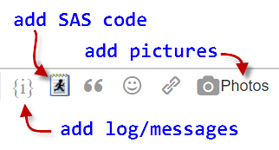- Home
- /
- Analytics
- /
- Stat Procs
- /
- Design of experiments across the time
- RSS Feed
- Mark Topic as New
- Mark Topic as Read
- Float this Topic for Current User
- Bookmark
- Subscribe
- Mute
- Printer Friendly Page
- Mark as New
- Bookmark
- Subscribe
- Mute
- RSS Feed
- Permalink
- Report Inappropriate Content
Hi all,
I am trying to model a continous variable across the time with several timepoints (0,3,6,9 and 12 months) and 2 predictors.
One is continuous (5 and 10) and the other is categorical (A, B and C) and for each of the combinaison I have 30 replicates.
The relation between Y and the time is not expeted to be linear. My main concern is to study the behavior of Y along the time and see if the 2 predictors included in the experiment have an influence.
Which statistical methodology/SAS procedure would you recommend?
Here is what I've used so far:
ODS GRAPHICS ON;
PROC GLM DATA=STUDY PLOTS=ALL;
CLASS Component;
MODEL Y = Timepoint Timepoint*Timepoint Component Essai Essai*Timepoint Timepoint*Component / SOLUTION;
OUTPUT OUT=STUDY_results PREDICTED=pred RESIDUAL=res COOKD=Dcook RSTUDENT=rstud;
RUN;
Thanks in advance.
Cédric.
- Mark as New
- Bookmark
- Subscribe
- Mute
- RSS Feed
- Permalink
- Report Inappropriate Content
Hello @CedricLVQ,
Your question requires more details before experts can help. Can you revise your question to include more information?
Review this checklist:
- Specify a meaningful subject line for your topic. Avoid generic subjects like "need help," "SAS query," or "urgent."
- When appropriate, provide sample data in text or DATA step format. See this article for one method you can use.
- If you're encountering an error in SAS, include the SAS log or a screenshot of the error condition. Use the Photos button to include the image in your message.
- It also helps to include an example (table or picture) of the result that you're trying to achieve.
To edit your original message, select the "blue gear" icon at the top of the message and select Edit Message. From there you can adjust the title and add more details to the body of the message. Or, simply reply to this message with any additional information you can supply.
SAS experts are eager to help -- help them by providing as much detail as you can.
This prewritten response was triggered for you by fellow SAS Support Communities member @sld
.- Mark as New
- Bookmark
- Subscribe
- Mute
- RSS Feed
- Permalink
- Report Inappropriate Content
Hmm. You can ignore this post from Community_Guide that is attributed to me. I don't know how it happened.
I have more specific comments in my other post.
- Mark as New
- Bookmark
- Subscribe
- Mute
- RSS Feed
- Permalink
- Report Inappropriate Content
Do you have a repeated measures design? In other words, is Y measured at each of several TIMEPOINTs (0, 3, 6, 9, 12) for each subject? Or is each subject measured at only one timepoint? The choice of appropriate procedure and the specification of the correct statistical model depends on the experimental design; if you have repeated measures, then you would use MIXED or GLIMMIX rather than GLM.
Although you have a "continuous" factor (Essai?), it apparently has only two levels; I would incorporate it as a categorical (classification) factor in the statistical model.
You could use TIMEPOINT as a continuous factor, but you say that you do not expect it to have a linear relationship with the response Y. So I would initially incorporate TIMEPOINT as a categorical factor. You might find that you can fit some form of linear model (e.g., curvilinear, like the quadratic specification in your MODEL statement) or a spline, but without seeing the data, we cannot tell.
If COMPONENT, ESSAI and TIMEPOINT are categorical factors (and so included in the CLASS statement), then you would have a 3-way factorial which may, or may not, include all possible interactions. If multiple observations are made on each subject, then you would have a mixed model.
I hope this helps. Follow up as need be.
April 27 – 30 | Gaylord Texan | Grapevine, Texas
Registration is open
Walk in ready to learn. Walk out ready to deliver. This is the data and AI conference you can't afford to miss.
Register now and lock in 2025 pricing—just $495!
ANOVA, or Analysis Of Variance, is used to compare the averages or means of two or more populations to better understand how they differ. Watch this tutorial for more.
Find more tutorials on the SAS Users YouTube channel.




